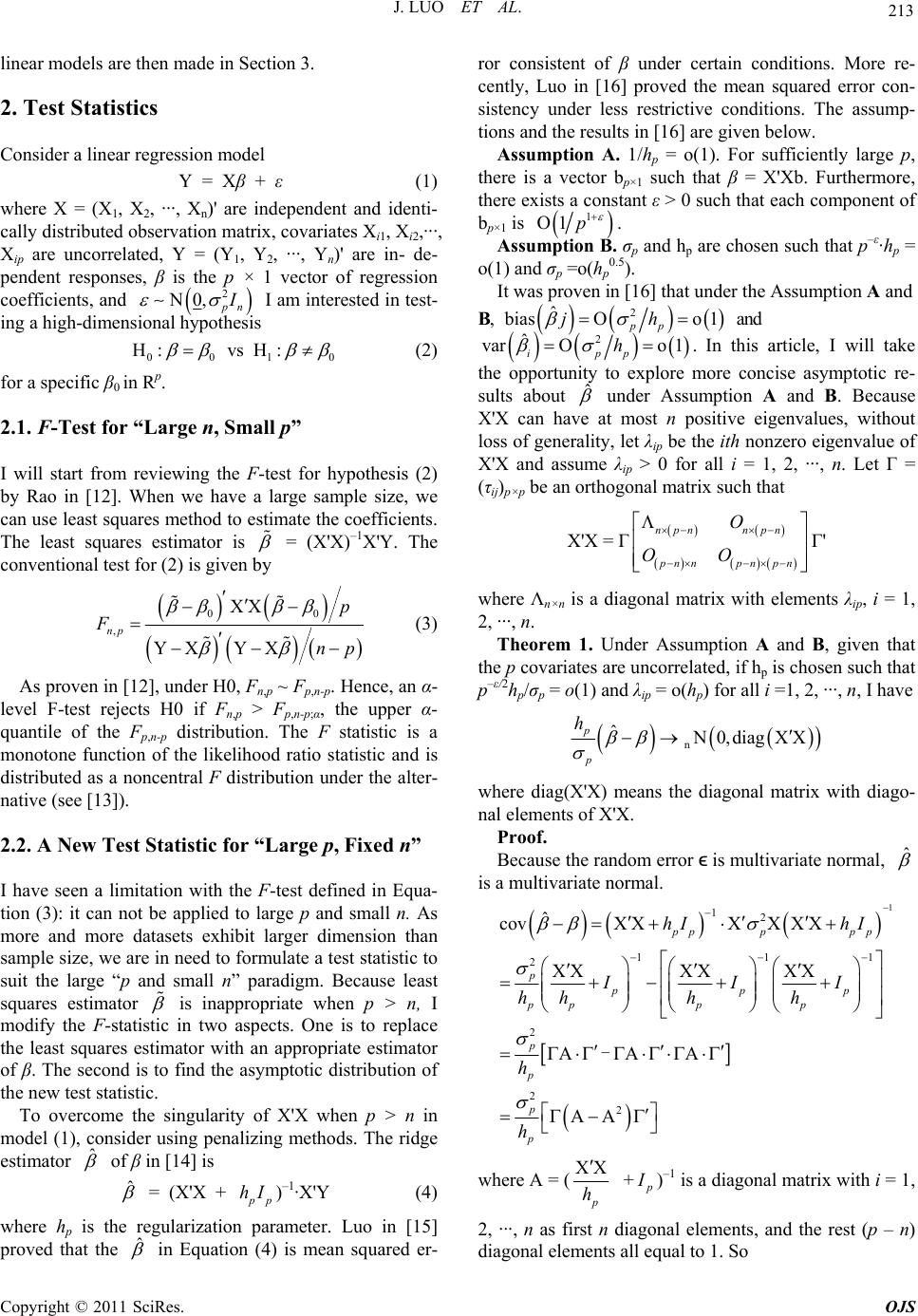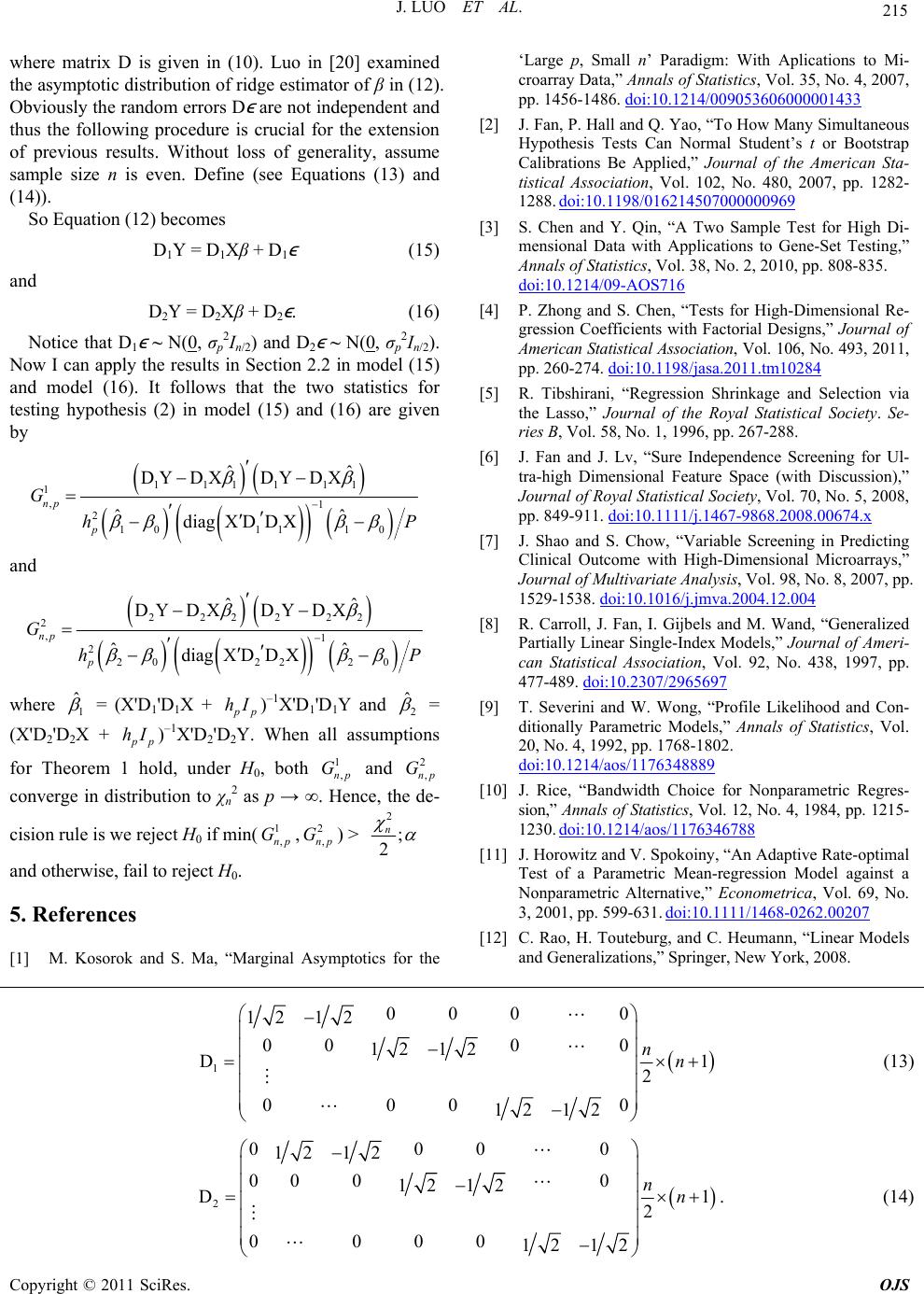 Open Journal of Statistics, 2011, 1, 212-216 doi:10.4236/ojs.2011.13025 Published Online October 2011 (http://www.SciRP.org/journal/ojs) Copyright © 2011 SciRes. OJS A New Test for Large Dimensional Regression Coefficients June Luo1, Yi-Jun Zuo2 1Department of Mathematical Sciences, Clemson University, Clemson, USA 2Department of Statistics and Probability, Michigan State University, Lansing, USA E-mail: jluo@clemson.edu Received August 19, 2011; revised September 22, 2011; accepted September 30, 2011 Abstract In the article, hypothesis test for coefficients in high dimensional regression models is considered. I develop simultaneous test statistic for the hypothesis test in both linear and partial linear models. The derived test is designed for growing p and fixed n where the conventional F-test is no longer appropriate. The asymptotic distribution of the proposed test statistic under the null hypothesis is obtained. Keywords: High Dimension, Ridge Regression, Hypothesis Test, Partial Linear Model, Asymptotic 1. Introduction Some high dimensional data, such as gene expression datasets in microarray, exhibits the property that the number of covariates greatly exceeds the sample size. The discovery of “large p, small n” paradigm brings challenges to many traditional statistical methods, and thus the asymptotic properties of various estimators when p goes to infinity much faster than n have been discussed (see [1-3]). Reference [1] considered uniform convergence for a large number of marginal discrepancy measures targeted on univariate distributions, means and medians. Reference [3] proposed a two sample test on high dimensional means. Both of these aforementioned articles considered testing under “large p, small n” without a regression structure, which the present article concentrates on. Zhong and Chen in [4] proposed a test statistic for testing the regression coefficients in linear models when p/n → ρ in (0,1). As in microarray data, the number of genes (p) is in the order of thousands whereas the sample size (n) is much less, usually less than 50 due to limitation for replications. The fact results in p going to infinity and thus I think the consideration of p going to infinity and n remains constant is more practical. Covariate selection for high dimensional linear regres- sion has received considerable attention in recent years. Penalizing methods are alternatives to the traditional least squares estimator for shrinkage estimation as in [5, 6]. Shao and Chow in [7] proposed a variable screening method using ridge estimators as both p and n go to infinity. In contrast to the assumptions in the literature, I consider “large p, fixed n” setting in linear models for variable selection. Testing hypothesis on the regression coefficients is critical in determining the effects of covariates on certain outcome variable. Motivated by the latest need in biology to identify significant sets of genes, rather than individual gene, I aim at developing simultan- eous tests for coefficients in linear regression models. The partial linear models have been extensively studied. They have a wide range of applications, from statistics to biomedical sciences. In these models, some of the relations are believed to be of certain parametric form while others are not easily parameterized. Several approaches have been developed to construct estimators. A profile likelihood approach was used in [8,9]. In this article, I apply a difference based estimation method in the partial linear models. The method of taking differ- ences to eliminate the effect of the unknown nonpa- rametric component has been used in both nonparametric and semiparametric settings. Rice in [10] first introduced a differencing estimator of the residual variance. Horo- witz and Spokoiny in [11] used the differencing method to test between a parametric model and a nonparametric alternative. After taking the differences to eliminate the bias induced from the nonparametric term, I concentrate attention on estimating the linear component and then formulate the test statistic for testing the linear compo- nents. The article begins with the conventional F-test. I will then discuss the efficiency of ridge estimator and pro- pose a new test statistic for “large p, fixed n” setting. The asymptotic distribution of the proposed test statistic under null hypothesis is established. Extensions to partial  213 J. LUO ET AL. linear models are then made in Section 3. 2. Test Statistics Consider a linear regression model Y = Xβ + ε (1) where X = (X1, X2, ..., Xn)' are independent and identi- cally distributed observation matrix, covariates Xi1, Xi2,..., Xip are uncorrelated, Y = (Y1, Y2, ..., Yn)' are in- de- pendent responses, β is the p × 1 vector of regression coefficients, and 2 N0, n I am interested in test- ing a high-dimensional hypothesis 001 H: vs H:0 (2) for a specific β0 in Rp. 2.1. F-Test for “Large n, Small p” I will start from reviewing the F-test for hypothesis (2) by Rao in [12]. When we have a large sample size, we can use least squares method to estimate the coefficients. The least squares estimator is = (X'X)–1X'Y. The conventional test for (2) is given by 00 , XX YX YX np p F np (3) As proven in [12], under H0, Fn,p ~ Fp,n-p. Hence, an α- level F-test rejects H0 if Fn,p > Fp,n-p;α, the upper α- quantile of the Fp,n-p distribution. The F statistic is a monotone function of the likelihood ratio statistic and is distributed as a noncentral F distribution under the alter- native (see [13]). 2.2. A New Test Statistic for “Large p, Fixed n” I have seen a limitation with the F-test defined in Equa- tion (3): it can not be applied to large p and small n. As more and more datasets exhibit larger dimension than sample size, we are in need to formulate a test statistic to suit the large “p and small n” paradigm. Because least squares estimator is inappropriate when p > n, I modify the F-statistic in two aspects. One is to replace the least squares estimator with an appropriate estimator of β. The second is to find the asymptotic distribution of the new test statistic. To overcome the singularity of X'X when p > n in model (1), consider using penalizing methods. The ridge estimator ˆ of β in [14] is ˆ = (X'X + p hI )–1·X'Y (4) where hp is the regularization parameter. Luo in [15] proved that the ˆ in Equation (4) is mean squared er- ror consistent of β under certain conditions. More re- cently, Luo in [16] proved the mean squared error con- sistency under less restrictive conditions. The assump- tions and the results in [16] are given below. Assumption A. 1/hp = o(1). For sufficiently large p, there is a vector bp×1 such that β = X'Xb. Furthermore, there exists a constant ε > 0 such that each component of bp×1 is 1 O1p . Assumption B. σp and hp are chosen such that p–ε·hp = o(1) and σp =o(hp 0.5). It was proven in [16] that under the Assumption A and B, 2 ˆ iasOo 1 pp jh and 2 ˆ varOo 1 ipp h . In this article, I will take the opportunity to explore more concise asymptotic re- sults about ˆ under Assumption A and B. Because X'X can have at most n positive eigenvalues, without loss of generality, let λip be the ith nonzero eigenvalue of X'X and assume λip > 0 for all i = 1, 2, ..., n. Let Г = (τij)p×p be an orthogonal matrix such that X'X = Г npn npn pn npnpn O OO Г' where Λn×n is a diagonal matrix with elements λip, i = 1, 2, ..., n. Theorem 1. Under Assumption A and B, given that the p covariates are uncorrelated, if hp is chosen such that p–ε/2hp/σp = o(1) and λip = o(hp) for all i =1, 2, ..., n, I have n ˆN0,diagXX p p h where diag(X'X) means the diagonal matrix with diago- nal elements of X'X. Proof. Because the random error ϵ is multivariate normal, ˆ is a multivariate normal. 1 12 11 2 2 2 2 ˆ covX XXXX X XXXX XX AAA AA pp ppp p pp pppp p p p p hI hI III hhhh h h 1 p - where A = ( XX h + )–1 is a diagonal matrix with i = 1, 2, ..., n as first n diagonal elements, and the rest (p – n) diagonal elements all equal to 1. So Copyright © 2011 SciRes. OJS  J. LUO ET AL. 214 22 2 22 1 ˆ var n pp jij i ppip h hh ip for all j = 1, 2, ..., p. Under the assumption λip = o(hp) for all i = 1, 2, ..., n, 2 2 lim 1 p p pip h h for all i = 1, 2, ..., n. Notice that 2 1 n iijip λip is the jth diagonal element of X'X, we have 2 2 ˆ limvardiagXX p j pp h for all j = 1, 2, ..., p. where diag(X’X)j means the jth diagonal element of X’X. Given that the p covariates are uncorrelated, I conclude 2 2 ˆ limcovdiagX X p pp h (5) As in [16], the bias(ˆ ) = O(p–εhp) = o(1), the assump- tion that p–ε/2hp/σp = o(1) guarantees bias(ˆ )hp/σp = o(1). Along with result in (5), that completes the proof for Theorem 1. Now I can modify the Fn,p to a test statistic for “large p, fixed n” paradigm. Define ,1 2 0 ˆˆ ˆˆ diagX X np p YX YX G h 0 p . (6) Under assumption A and B, as p → ∞, ˆ in Equation (4) is mean squared error consistent of β which implies ˆ converges in probability to β. Apply the continuous mapping theorem, 2 22 ˆˆ converges in probability to ˆˆ p pp YX YX YX YX which is χn 2 distribution. Under H0 as p → ∞, by Theo- rem 1, 21 00 2 ˆˆ diagX X p p h converges to χp 2 distribution. By Law of large numbers, 21 0 2 ˆˆ diagX X p p hp 0 converges to 1. Apply the Slutsky’s theorem, I conclude that under H0, test statistic Gn,p in Equation (6) converges in distribution to χn 2 as p → ∞ and n is a fixed constant. Hence, an α-level Gn,p statistic rejects H0 if Gn,p > χn;α 2, the upper α quantile of the χn 2 distribution. 3. Extension to Partial Linear Models Partial linear models are more flexible than standard linear models. They can be a suitable choice when one suspects that the response Y linearly depends on X, but Y is nonlinearly related to Z. Consider a fix design version of the partial linear model which has the matrix form Y = Xβ + f(Z) + ϵ (7) where Y = (Y1, Y2, ..., Yn+1)', X is a (n + 1) × p matrix whose ith row is given by xi, the p covariates of xi are uncorrelated and ϵ = ( ϵ 1, ϵ 2, ..., ϵ n+1)' is normally distributed with a mean vector 0 and covariance matrix 2 1 n . Estimators of the linear component for n > p situation have been discussed in [17-19]. The methods are not applicable for p > n, I propose the following procedure to obtain a statistic for hypothesis (2) in partial linear model (7). Assume the sequence {zi}→ c0 as p → ∞, for all i = 1, 2, ..., n + 1, where c0 is a finite constant. The unknown function f is continuous at point c0. Consider yi+1 – yi = (xi+1 – xi)β + f(zi+1) – f(zi) + ϵ i+1 – ϵ i. (8) Since zi → c0 for all i = 1, 2, ..., n + 1, for any ψ > 0, there exists a large enough p value so that we have 11 0 max in i zc . Function f is continuous at point c0, so for a large enough p, we have 11 0 max in i fz fc , which implies that for a finite n, 10 1 max (1) i in zfzo (9) Define a matrix 110 00 01 100 D1 00011 nn . (10) We now consider the matrix form of Equation (8), which is DY = DXβ + Df(Z) + D ϵ . (11) Because of Equation (9), I can ignore the presence of nonparametric part in model (11). Thus, (11) becomes DY = DXβ + D ϵ (12) Copyright © 2011 SciRes. OJS  215 J. LUO ET AL. where matrix D is given in (10). Luo in [20] examined the asymptotic distribution of ridge estimator of β in (12). Obviously the random errors D ϵ are not independent and thus the following procedure is crucial for the extension of previous results. Without loss of generality, assume sample size n is even. Define (see Equations (13) and (14)). So Equation (12) becomes D1Y = D1Xβ + D1 ϵ (15) and D2Y = D2Xβ + D2 ϵ . (16) Notice that D1 ϵ ~ N(0, σp 2In/2) and D2 ϵ ~ N(0, σp 2In/2). Now I can apply the results in Section 2.2 in model (15) and model (16). It follows that the two statistics for testing hypothesis (2) in model (15) and (16) are given by 111111 1 ,1 2 1011 10 ˆˆ DY DXDY DX ˆ diagXDD X np p G h ˆ P and 222222 2 ,1 2 2022 20 ˆˆ DY DXDY DX ˆ diagX DDX np p G h ˆ P where 1 ˆ = (X'D1'D1X + p hI )–1X'D1'D1Y and 2 ˆ = (X'D2'D2X + p hI )–1X'D2'D2Y. When all assumptions for Theorem 1 hold, under H0, both and converge in distribution to χn 2 as p → ∞. Hence, the de- 1 ,np G2 ,np G cision rule is we reject H0 if min(,) > 1 ,np G2 ,np G 2 ; 2 n and otherwise, fail to reject H0. 5. References [1] M. Kosorok and S. Ma, “Marginal Asymptotics for the ‘Large p, Small n’ Paradigm: With Aplications to Mi- croarray Data,” Annals of Statistics, Vol. 35, No. 4, 2007, pp. 1456-1486. doi:10.1214/009053606000001433 [2] J. Fan, P. Hall and Q. Yao, “To How Many Simultaneous Hypothesis Tests Can Normal Student’s t or Bootstrap Calibrations Be Applied,” Journal of the American Sta- tistical Association, Vol. 102, No. 480, 2007, pp. 1282- 1288. doi:10.1198/016214507000000969 [3] S. Chen and Y. Qin, “A Two Sample Test for High Di- mensional Data with Applications to Gene-Set Testing,” Annals of Statistics, Vol. 38, No. 2, 2010, pp. 808-835. doi:10.1214/09-AOS716 [4] P. Zhong and S. Chen, “Tests for High-Dimensional Re- gression Coefficients with Factorial Designs,” Journal of American Statistical Association, Vol. 106, No. 493, 2011, pp. 260-274. doi:10.1198/jasa.2011.tm10284 [5] R. Tibshirani, “Regression Shrinkage and Selection via the Lasso,” Journal of the Royal Statistical Society. Se- ries B, Vol. 58, No. 1, 1996, pp. 267-288. [6] J. Fan and J. Lv, “Sure Independence Screening for Ul- tra-high Dimensional Feature Space (with Discussion),” Journal of Royal Statistical Society, Vol. 70, No. 5, 2008, pp. 849-911. doi:10.1111/j.1467-9868.2008.00674.x [7] J. Shao and S. Chow, “Variable Screening in Predicting Clinical Outcome with High-Dimensional Microarrays,” Journal of Multivariate Analysis, Vol. 98, No. 8, 2007, pp. 1529-1538. doi:10.1016/j.jmva.2004.12.004 [8] R. Carroll, J. Fan, I. Gijbels and M. Wand, “Generalized Partially Linear Single-Index Models,” Journal of Ameri- can Statistical Association, Vol. 92, No. 438, 1997, pp. 477-489. doi:10.2307/2965697 [9] T. Severini and W. Wong, “Profile Likelihood and Con- ditionally Parametric Models,” Annals of Statistics, Vol. 20, No. 4, 1992, pp. 1768-1802. doi:10.1214/aos/1176348889 [10] J. Rice, “Bandwidth Choice for Nonparametric Regres- sion,” Annals of Statistics, Vol. 12, No. 4, 1984, pp. 1215- 1230. doi:10.1214/aos/1176346788 [11] J. Horowitz and V. Spokoiny, “An Adaptive Rate-optimal Test of a Parametric Mean-regression Model against a Nonparametric Alternative,” Econometrica, Vol. 69, No. 3, 2001, pp. 599-631. doi:10.1111/1468-0262.00207 [12] C. Rao, H. Touteburg, and C. Heumann, “Linear Models and Generalizations,” Springer, New York, 2008. 1 000 0 12 12 000 0 12 12 D1 2 000 0 12 12 nn (13) 2 0000 12 12 00 00 12 12 D1 2 0000 12 12 nn . (14) Copyright © 2011 SciRes. OJS  J. LUO ET AL. Copyright © 2011 SciRes. OJS 216 [13] T. Anderson, “An Introdution to Multivariate Statistical Analysis,” Wiley, Hoboken, 2003. [14] A. Hoerl and R. Kennard, “Ridge Regression Biased Es- timation for Nonorthogonal Problems,” Technometrics, Vol. 12, No. 1, 1970, pp. 55-67. doi:10.2307/1267351 [15] J. Luo, “The Discovery of Mean Square Error Consis- tency of Ridge Estimator,” Statistics and Probability Let- ters, Vol. 80, No. 5, 2010, pp. 343-347. doi:10.1016/j.spl.2009.11.008 [16] J. Luo, “Asymptotical Properties of Coefficient of De- termination for Ridge Regression with Growing Dimen- sions,” Oriental Journal of Statistical Methods, Theory and Applications, Vol. 1, No. 1, 2011, pp. 41-49. [17] L. Wang, L. Brown and T. Cai, “A Difference Based Approach to Semiparametric Partial Linear Model,” Elec- tronic Journal of Statistics, Vol. 5, 2011, pp. 619-641. [18] A. Yatchew, “An Elementary Estimator of the Partial Linear Model,” Economics Letters, Vol. 57, No. 2, 1997, pp. 135-143. doi:10.1016/S0165-1765(97)00218-8 [19] A. Yatchew, “Scale Economies in Electricity Distribution: A Semiparametric Analysis,” Journal of Applied Eco- nomics, Vol. 15, No. 2, 2000, pp. 187-210. [20] J. Luo, “Asymptotic Efficiency of Ridge Estimator in Linear and Semiparametric Linear Models,” Statistics and Probability Letters, Vol. 82, No. 1, 2011, pp.58-62. doi:10.1016/j.spl.2011.08.018.
|